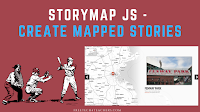Click here to read this mailing online.
Here are the latest updates for nurhasaan10@gmail.com "Free Technology for Teachers" - 2 new articlesAbout Primary SourcesAs a U.S. History teacher one my primary goals was to help students understand the past to understand where we (Americans) came from to understand how we got here and to, hopefully, avoid mistakes of the past. To that end, I frequently had students read excerpts from primary source documents. Sometimes that meant confronting language and sentiments while common at the time of writing would be completely unacceptable if they were written today. Confronting primary source documents whose content if written today would be completely unacceptable becomes a very teachable moment in terms of helping students understand the context (physical as well as political and cultural) in which the documents were written. It's also an opportunity to teach how and why change happened. It is difficult to teach with primary sources if students don't first fully understand the differences between primary and secondary sources. That's every year that I taught U.S. History began with lessons on identifying primary and locating primary source documents. To that end, I have a few resources that helped me help my students and I hope will help you as well. Compare textbooks, primary sources, and Wikipedia.This is a rather simple activity that I've done over the years as an introduction to the value of primary sources. In the activity I provide students with a textbook entry, a Wikipedia entry, and a primary source document about the same event or topic. I then have them read all three and compare the information about the event. The outline of questions for students is available in this Google Document that I created. Guided reading of primary sources through Google Documents. One of my favorite ways to use the commenting feature in Google Documents is to host online discussions around a shared article. Through the use of comments connected to highlighted sections of an article I can guide students to important points, ask them questions, and allow them to ask clarifying questions about the article. All the steps for this process are outlined in Using Google Documents to Host Online Discussions of Primary Sources. A variation on this activity can be completed with Formative. I outlined that process here. What's the Difference Between a Primary and a Secondary Source? The Gale Family Library at the Minnesota History Center offers this good and concise video explanation for students. My friends Lee and Sachi at Common Craft also offer an excellent video explanation of the differences between primary and secondary sources. Disclosure: I have a long-standing in-kind relationship with Common Craft. StoryMap JS - A Nice Alternative to Tour BuilderLike many teachers, I was disappointed when Google deprecated Tour Builder and Tour Creator last year. Since then in my webinar series with Rushton Hurley and on social media I've answered a lot of questions from teachers about alternatives to Tour Builder. StoryMap JS is one of the tools that I've been suggesting when asked for Tour Builder alternatives. That's why earlier this week when I got a Twitter DM from a teacher in Texas who was looking for a Tour Builder alternative I decided to create a new tutorial video about using StoryMap JS. In this tutorial video I demonstrate how you can use StoryMap JS as an alternative to Tour Builder. In the tutorial I include directions for incorporating Google Street View imagery into your mapped stories built with StoryMap JS. Applications for Education Building a storymap with Storymap JS provides a good way for students to make connections between historical events and their locations. For example, in the storymap I made in the video above I included a reference to the New York Yankees losing the 2004 American League championship to the Boston Red Sox in an unprecedented and historic fashion. More Recent Articles |
Email subscriptions powered by FeedBlitz, LLC • 1800 Camden Road, Suite 107-258 • Charlotte, NC 28203, USA
« Prev Post
Next Post »





ConversionConversion EmoticonEmoticon